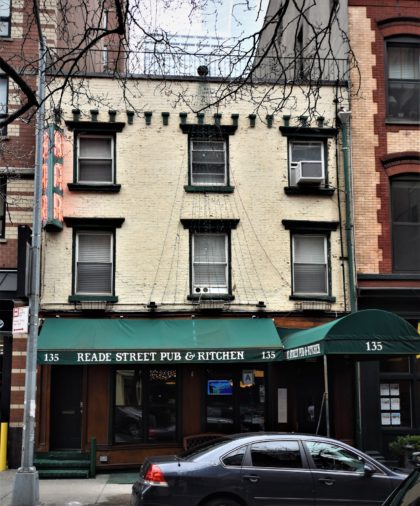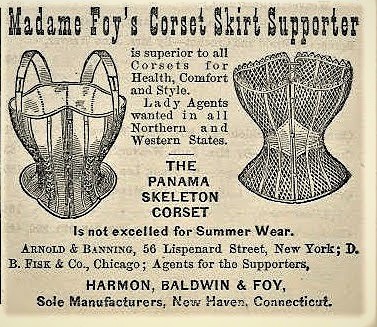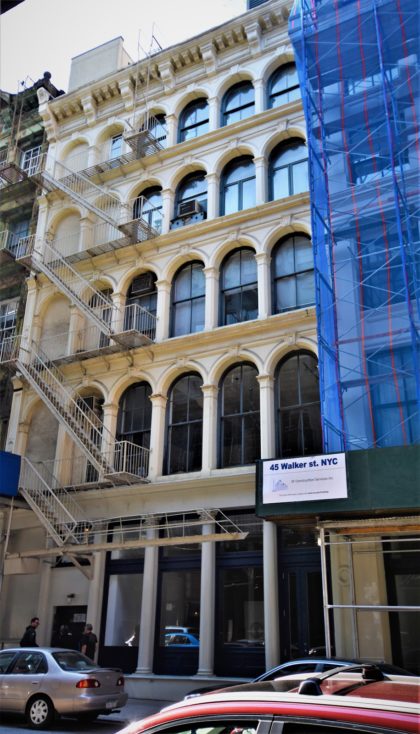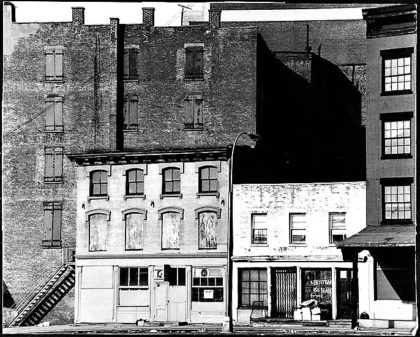The History of Tribeca, One Building at a Time
The History of Tribeca Buildings database—compiled from Tom Miller’s posts at Daytonian in Manhattan—has six more entries on the properties below. (Click the address to read the full text.) If you enjoy these, and you will, then you should definitely check out his website, which also has write-ups about buildings all over the island. And don’t miss his book, Seeking New York: The Stories Behind the Historic Architecture of Manhattan—One Building at a Time.
··················
 135 READE
135 READE
When Prohibition was enacted in 1920, it changed everything for the business at No. 135 Reade Street—or at least it was supposed to. Policeman Carl Zipf took his job and the 18th Amendment seriously. On April 14, 1921, he devised a sneaky scheme to root out bootleggers that involved wearing street clothes rather than his uniform. The New-York Tribune reported, “Pausing before the building at 135 Reade Street, which formerly housed a licensed saloon, he leaned against the wall, clutched himself at the second button of his single-breasted sack suit, and began to moan.” The porter, Leo Busch, heard the sounds of distress and came out to help. Zipf “gasped a plea for a drink.” And when Busch returned with a glass of whisky, the officer “straightened up, and, placing a soft hand on Busch’s shoulder, informed him he was under arrest.”
··················
 56 LISPENARD
56 LISPENARD
Construction started in August of 1866. The newspaper placed its cost at $25,000 (about $418,000 today) and identified its owner as Judson & Leary. And there the mystery begins. The arcane partners were possibly dry goods dealers or merely two businessmen dabbling in real estate. The Landmarks Preservation Commission simply describes them saying, “about whom nothing is known.” Equally puzzling is their architect of record, J. Van Riper. If, indeed, Van Riper drew the plans for the structure, he most likely drew his inspiration entirely from style books. His listed profession was not architect, but contractor; a partner in J. & J. Van Riper, “masons and builders.”
··················
 47 WALKER
47 WALKER
During World War II, women took factory jobs as male employees went to Europe to fight. One of them was Belle Calloun, who was hired to work at the Lincoln Wire Company in the fall of 1942. Starting out with no skills, the 29-year old Queens resident achieved the position of chief wire machine operator within eight months. She received a national honor on May 25, 1943, which most today would view as racist and demeaning. The New York Times announced that she “has been selected as ‘Miss Negro War Worker’” and reported she would “receive a $25 War Bond at the Negro Freedom Rally show at Madison Square Garden on June 7.” The article explained that her selection was based in part on her perfect attendance and her membership in the labor-management committee of the factory.
··················
 158 READE
158 READE
Butter and eggs jobbers Samuel Pfeiffer and I. Roth were here by 1930, when the industry was terrorized by the mob. On August 19, 1930, the New York Times reported that a hearing held by the Attorney General the day before had exposed “a widespread organization of ‘racketeers, guerrillas and gangsters.’” Pfeiffer and Roth both testified, despite what the Assistant Attorney General said were definite threats by the mob “to kill any one who persisted in defying the gang’s will.” Butter and egg dealers who balked at the mob’s price fixing told of having the tires on their delivery trucks slashed and their customers being intimidated to cease doing business with them. I. Roth’s reluctance to testify prompted Assistant Attorney General William B. Groat, Jr. to ask if he was afraid. Roth did say that he had been clearly warned against patronizing a Utah egg supplier who refused to work with the mob: “A few days ago a man I never saw before walked up to my place and told me to stop getting eggs from the Utah outfit. He told me I was a nice young fellow with a family and ‘it would be a shame to get bumped off.’” Pfeiffer was even less eager to talk. He pleaded, “I have a wife and children to support and I have to work.” Groat was not all that sympathetic. “Well, so have the people who buy eggs.”
··················
 324 CANAL
324 CANAL
In 1863, George T. Jackson demolished the three-story former house at No. 324 Canal Street to make way for a modern store and loft building. Completed the following year, the five-story structure was faced in marble above the cast-iron storefront. Jackson’s unknown architect designed the 20-foot wide edifice in the popular Italianate style. The central section of the tripartite design featured three two-story arches separated by paneled Corinthian pilasters, and heavy scrolled keystones broke like waves over the molded arches. The top two floors mimicked the lower section with slightly less grandeur. In 1875, Jackson tore down the old two-story building at No. 43 Lispenard Street and replaced it with a proper five-story annex to the Canal Street building. The architect carried over the architectural motif in brick and stone in the two two-story arches, the beefy keystones, and the cast-iron storefront.
··················
 165 DUANE
165 DUANE
In 1886, Finance and Industry noted, “The name of L. Schepp has become a household word throughout the United States.” Leopold Schepp started his career in 1851 with 18 cents his mother gave him. He bought a dozen palm-leaf fans for 1.5 cents each, and then sold them on the Third Avenue street cars for 5 cents. He later said, “They sold so fast that the third day I hired three other boys on commission and soon I was making $15 a week.” By 1871, he had established the importing firm of L. Schepp & Co., and two years later focused his attention on coconuts—a food item mostly overlooked in America. Although wealthy and influential, Schepp was known for his “unparliamentary language,” as described by The New York Times, and for his temper, which the same newspaper said “would make the North Pole melt.” That temper came into play in 1889, when the Colombian Government began interfering with American trade. It started on October 2 when the gunboat La Popa seized The Pearl, a schooner owned by New York City merchant James Herron. “She was taken to Carthagens and held subject to confiscation for smuggling,” reported the Pittsburgh Dispatch. Shortly after, The Julian was overtaken and towed to Carthagens, “and there she now lies, with her captain and crew prisoners,” and when Foster & Co. sent a second vessel, the Edith B. Coombs, to retrieve its perishable cargo, that ship, too, was captured. Although the State Department began diplomatic negotiations, Leopold Schepp had no time for that. On January 1, 1890, the Pittsburgh Dispatch reported, “The firm of L. Schell & Co., importers… has declared war against the United States of Colombia. At least, they have sent an armed vessel to Colon and the coast of Panama, with instructions to make forcible resistance if the gunboat La Popa, which recently seized several trading vessels, should attempt to interfere with her.” Schepp outfitted the firm’s schooner George W. Whitford with “two cannon, rifles and revolvers and plenty of ammunition.” The show of force worked.
··················














i look forward to reading the Daytonian in Manhattan posts- no matter the neighborhood- but particularly TriBeCa